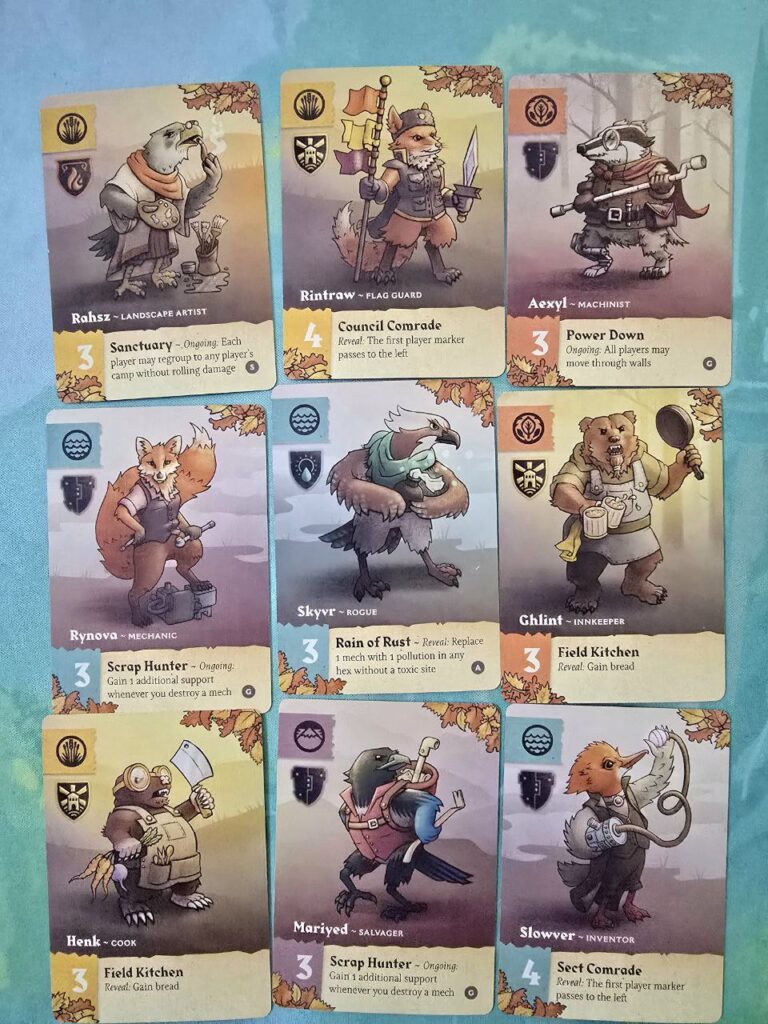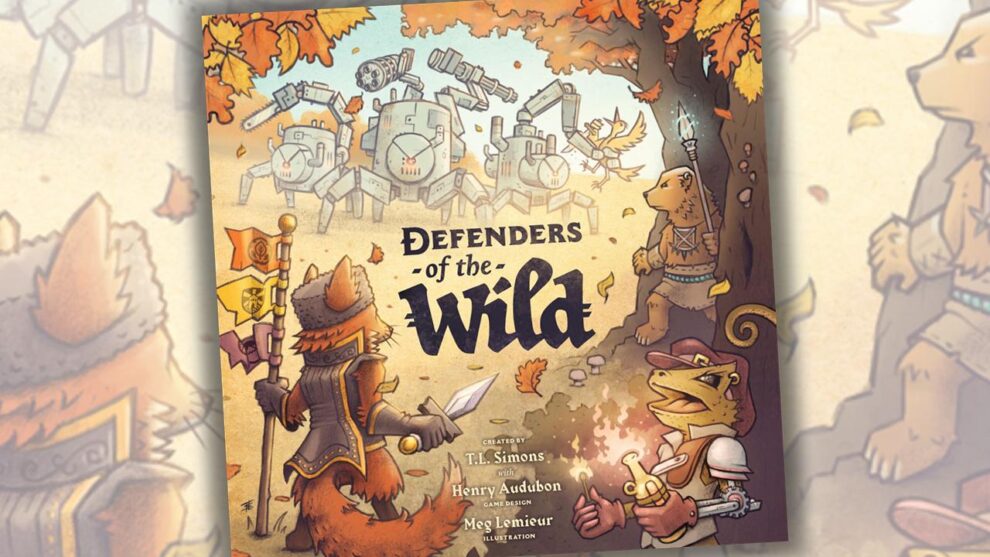Disclosure: Meeple Mountain received a free copy of this product in exchange for an honest, unbiased review. This review is not intended to be an endorsement.
Into the Commonwood
Defenders of the Wild is a game that flew under the radar, which is surprising given its small box, Root-esque look, and the design backing of Henry Audubon (PARKS) and T.L. Simons (Bloc by Bloc). The game was brought to life as Outlandish Games’ first Kickstarter, which successfully raised over $330,000 from 1,200 backers. There is even a spinoff RPG book titled The Almanac that fleshes out the factions and worldbuilding. Outlandish Games focuses on titles that explore conflict, cooperation, power, and resistance.
The game is thematically rich, immersing players in the world of Commonwood, where the livelihood of the inhabitants is threatened by robotic machines imbued with corrupted magic. Players choose leaders from four partisan factions who mistrust one another but must cautiously unite to face a common enemy. The booklet includes a wealth of backstory for each faction, along with an in-depth narrative about the world as a whole. I was surprised to find so much content about these little critters, but it helped set the stage for the cooperative bout we were about to embark on. This backdrop of collective good is common in the cooperative genre, including titles such as Spirit Island, Aeon’s End, Heredity: The Book of Swan, and Horrified. Critter collusion awaits!

Critters and Conflict
Defenders of the Wild plays in turns until either the success condition is met or one of the various defeat conditions occurs. Players collectively win if all factions have individually built all their bases and all factories have been “rewilded.” Conversely, players lose if two of the same defender types are killed, five factories are built, or six toxic sites are spread across the board. Each faction has a choice of two organizers, each with an asymmetric deck of defenders.

At the start of each round, players silently select a defender from their hand to play. Defenders may produce ongoing or revealed effects at this stage. Players then carry out actions in turn order, ranging from moving, clearing pollution, breaching walls, defeating mechs, gaining items, or building camps—all while trying to gain support. Players track support on individual boards, generated from various actions. When support reaches the maximum, that player can build a camp on their matching habitat, inching closer to victory. Movement across the board can be hindered by walls, which players must breach to pass through. Players can also recall and heal at deployed camps.

However, the machines fight back: at the end of each player’s turn, a semi-predictable machine card is drawn. These effects range from moving the engines, spawning mechs or pollution, or building more factories. Every machine card increases adversity, tipping the scales against the team.

As play continues, individual players exit the game in reverse elimination fashion once they have built all their camps. Rounds continue until all players have exited (presumably winning) or until one of the three defeat conditions is met.
Creature Comforts
The game is undeniably charming. The art and aesthetics by Meg Lemieur and T.L. Simons heighten immersion, and the chunky wooden tokens add a strong table presence. Each card features unique art, and while the animal types/occupations are purely cosmetic, they add a personal pang of sorrow when one of them meets their untimely demise. For such a small box, the game packs a lot of content, including eight different possible decks and additional difficulty cards. When laid out, the game is reminiscent of Catan, but the shading and color palette of the theme make me yearn for fall weather.

Forest Falters
I very much wanted this to become a staple cooperative game in my collection. After multiple plays, however, that feeling quickly diminished, much to my disappointment. The overall task and systems of the co-op are sound, but the experience falls short of what it could have been.
Our first play felt longer than it should have. The rulebook is foggy and vague at times, making the rules feel fiddly. After a few rounds of constant rulebook-checking, we hit our stride and understood the flow better. Subsequent plays did cut down on time, but the game still overstayed its welcome, clocking in at two hours. Even achieving victory felt shallow, as though we had “lucked” into it rather than succeeding through smart planning.

Silently picking a defender is a miss. The rule may echo the factions’ mistrust, but it makes an already tough game harder. Strict communication limits work in games like The Crew, where secrecy is the puzzle, but here they cripple the strategic planning needed to win. Worse, if you lack a good defender, you’re forced to blindly flip the top card—undermining team strategy even more.
The movement of the machines and board seeding also felt clunky (pun intended), as finding the little arrows and lines was sometimes difficult to parse on a crowded board.
With only seven cards, the machine deck quickly becomes predictable. Adversity feels flat, replayability suffers, and even with modular boards, the core task never changes. Defender decks also blur together, adding to the sameness.
The exit mechanic is puzzling: once you finish your camps, you’re out. Some players sat frustrated, watching others finish the mission. You can delay your last camp to help longer, but every turn still spawns enemies—adding risk with little reward. For a fully cooperative game, this sudden shift from teammate to spectator felt like a big miss.
Mechanically, the decision space didn’t feel deep overall. Much like Pandemic, actions are tactical responses to the board state, with players running around putting out little fires. While this isn’t inherently bad, it results in a rinse-and-repeat cycle of clearing threats just to build camps, only to start again.
Verdict of the Wild
There are bright spots, such as the art, theme, and the multi-pronged puzzle structure. The production quality is fantastic, and the board presence stands out in a sea of cooperative games. Some systems are interesting—like limited breaches through walls or taking damage when near mechs—but they don’t shine enough to make the game memorable.

It’s a shame, because there’s a lot of potential here, especially from such strong designers. Many other cooperative games, however, simply run more smoothly. I imagine some co-op fans will enjoy the “on the rails” gameplay, but for me, unfortunately, this is one forest conflict I’ll be staying out of. Beautiful to look at, but not one I’ll be fighting to get back on the table.












Add Comment